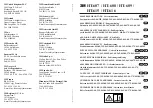NXP Semiconductors
FXTH87E
FXTH87E, Family of Tire Pressure Monitor Sensors
FXTH87ERM
All information provided in this document is subject to legal disclaimers.
© NXP B.V. 2019. All rights reserved.
Reference manual
Rev. 5.0 — 4 February 2019
25 / 183
Parameter
Cycles of FCLK
Time if FCLK = 200 kHz
Page erase
4000
20 ms
Mass erase
20,000
100 ms
[1]
Excluding start/end overhead
6.7.3 Program and erase command execution
The steps for executing any of the commands are listed below. The FCDIV register must
be initialized and any error flags cleared before beginning command execution. The
command execution steps are:
1. Write a data value to an address in the FLASH array. The address and data
information from this write is latched into the FLASH interface. This write is a required
first step in any command sequence. For erase and blank check commands, the
value of the data is not important. For page erase commands, the address may be
any address in the 512-byte page of FLASH to be erased. For mass erase and blank
check commands, the address can be any address in the FLASH memory. Whole
pages of 512 bytes are the smallest block of FLASH that may be erased.
Do not program any byte in the FLASH more than once after a successful erase
operation. Reprogramming bits to a byte which is already programmed is not allowed
without first erasing the page in which the byte resides or mass erasing the entire
FLASH memory. Programming without first erasing may disturb data stored in the
FLASH.
2. Write the command code for the desired command to FCMD. The five valid
commands are blank check (0x05), byte program (0x20), burst program (0x25),
page erase (0x40), and mass erase (0x41). The command code is latched into the
command buffer.
3. Write a 1 to the FCBEF bit in FSTAT to clear FCBEF and launch the command
(including its address and data information).
A partial command sequence can be aborted manually by writing a 0 to FCBEF any
time after the write to the memory array and before writing the 1 that clears FCBEF and
launches the complete command. Aborting a command in this way sets the FACCERR
access error flag which must be cleared before starting a new command.
A strictly monitored procedure must be obeyed or the command will not be accepted.
This minimizes the possibility of any unintended changes to the FLASH memory
contents. The command complete flag (FCCF) indicates when a command is complete.
The command sequence must be completed by clearing FCBEF to launch the command.
Figure 9
is a flowchart for executing all of the commands except for burst programming.
The FCDIV register must be initialized before using any FLASH commands. This must be
done only once following a reset.
6.7.4 Burst program execution
The burst program command is used to program sequential bytes of data in less time
than would be required using the standard program command. This is possible because
the high voltage to the FLASH array does not need to be disabled between program
operations. Ordinarily, when a program or erase command is issued, an internal charge
pump associated with the FLASH memory must be enabled to supply high voltage to the
array. Upon completion of the command, the charge pump is turned off. When a burst
program command is issued, the charge pump is enabled and then remains enabled
after completion of the burst program operation if these two conditions are met:
Downloaded from
Downloaded from
Downloaded from
Downloaded from
Downloaded from
Downloaded from
Downloaded from
Downloaded from
Downloaded from
Downloaded from
Downloaded from
Downloaded from
Downloaded from
Downloaded from
Downloaded from
Downloaded from
Downloaded from
Downloaded from
Downloaded from
Downloaded from
Downloaded from
Downloaded from
Downloaded from
Downloaded from
Downloaded from


















